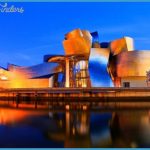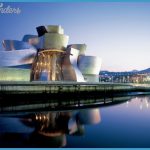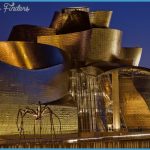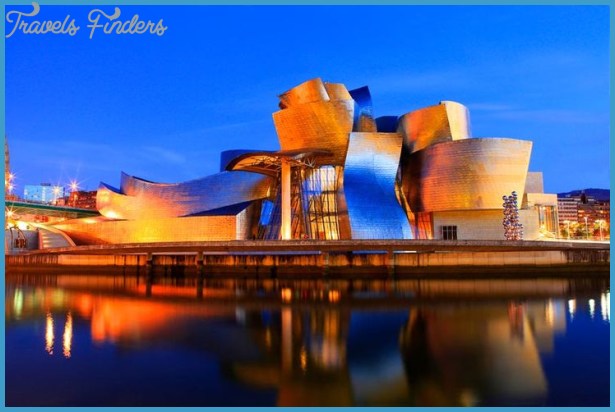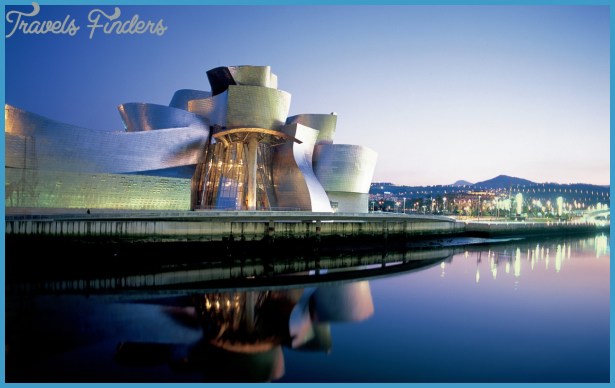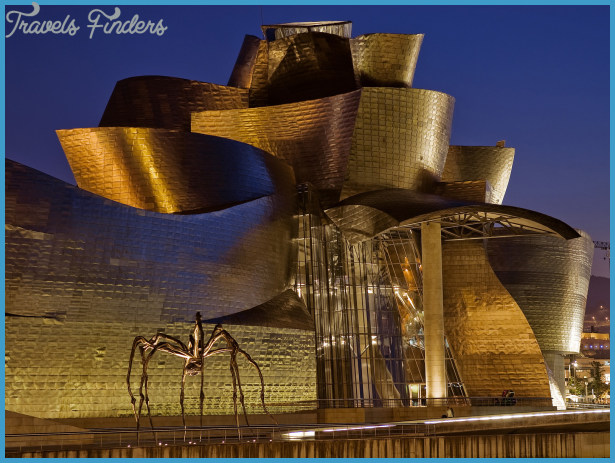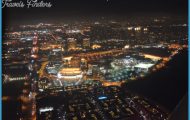FRANK GEHRY
The undulating, reflective forms of the Guggenheim Museum, Bilbao, make it one of the most famous buildings of recent decades. The museum was designed by California-based architect Frank Gehry, who insisted on situating it in the city’s run-down port area rather than on the downtown site originally proposed. Inspired by the scaly, shimmering forms of fish, Gehry created innovative architectural forms using a mix of straight, stone-covered walls and curving shapes clad in titanium over a steel frame. Appearing almost as if piled up at random and about to topple over, these dazzling structures were the result of Gehry’s daring imagination combined with his team’s mastery of computer-aided design. The bold, rounded shapes catch the sunlight, while the gaps and folds between them create intriguing shadows, which invite exploration.
Inside, the building is equally stunning. A full-height atrium leads to uniquely shaped galleries a trapezoid, an L-shaped space, and a long, boat-shaped gallery while on the upper floor, the galleries are more conventional. The resulting mix of spaces is perfectly suited to displaying the wide range of modern art in the Guggenheim’s collection.
The building’s resemblance to a collection of fragments and its strong, non-linear geometry have made some design critics suggest that the museum is an example of the architectural movement known as deconstructivism, a style typified by fragmentation and unpredictability that became fashionable in the late 1980s. Gehry, however, refutes such categorization and his buildings work on their own terms, capturing the imagination.
The Guggenheim attracts twice as many visitors as the ambitious target of 500,000 per year a massive influx of people. The city of Bilbao has reaped the economic benefits brought by the museum, with the income aiding the regeneration of the port area a triumph of urban renewal as well as of architecture.
FRANK GEHRY
Born in Toronto, Canada, Frank Gehry tried out different careers before studying architecture in Southern California. His first notable designs, however, were not architectural but for a range of furniture made out of cardboard. The building that helped establish his architectural credentials was his own house in Santa Monica, which combines corrugated metal, chain-link fencing, exposed framing, and other materials to create an arresting whole that some found disorienting. The house brought Gehry publicity and a host of commissions, allowing him to experiment with dramatic new forms, often on a large scale. Among his landmark structures are the Vitra Design Museum in Weil am Rhein, Germany; the Chiat/Day Building in Venice, California, which is partly shaped like a pair of binoculars; and the Frederick Weisman Museum of Art in Minneapolis, which has a multifaceted shimmering fagade similar to the Guggenheim. In over 50 years as an architect Gehry has continued to push the boundaries of architecture and devise innovative shapes and forms.
Visual tour
3 WATER GARDEN AND CANOPY Having chosen a site near Bilbao’s docks and river, Gehry wanted to bring water close to the building so he created a water garden by the walls of the museum. By extending the canopy out into the water, he further integrated the building and its setting. The structure’s complex surfaces are reflected by the gently rippling water, amplifying the shimmering effect of the Guggenheim’s titanium cladding.
The dramatically tilting tower marks the eastern end of the museum
3 EXTERIOR WALLS The building’s skin is a very thin layer of an alloy of titanium, a metal known for its resistance to heat and decay and used mainly in industries, such as aerospace and shipping. The skin appears to ripple in the wind, giving the impression that the building is alive, like the fish that inspired it. Gehry prized titanium for its reflective quality the skin changes color to reflect the blues and grays of the sky, and the glow of sunset or sunrise.
The long gallery stretches eastward, toward the Puente de la Salve
The water garden extends all the way along the side of the building
1 CLADDING AND WINDOWS Part of the art of the Guggenheim is the careful juxtaposition of very different materials and very distinct geometries. Here, the fluid curves that dominate the structure rise and dip past a window, which features straight lines set at unusual angles. As you walk around, the building reveals its surprises, such as the intersections of bright surfaces and deep, mysterious shadows. Each curve tempts you to explore further.
3 ATRIUM CEILING
The atrium’s huge windows, which flood the interior with light, are framed with steel jprights and glazing bars .,jt make an intricate netlike pattern of uprights, horizontals, curves, and diagonals. These patterns could be dazzling or baffling to the eye, but the white walls, which rise through more than 164ft (50m) to the ceiling, bring the spaces together and unify this complex design.
The walls on this side of the building are clad in thin panels of specially selected Spanish limestone
IN CONTEXT
Gehry often incorporates the idea of movement into his buildings. A good example is the Nationale-Nederlanden Building in Prague, Czech Republic. It has been nicknamed the Dancing House or Ginger and Fred Building, because its forms reflect the dancing figures of Fred Astaire (the round corner tower) and Ginger Rogers (the tapering, glass-enclosed form to the left). The rows of windows on the right-hand fagade correspond to those of 19th-century apartment houses nearby, but set at varying levels, they look as if they are on the move.
1 Dancing House
The curving shapes of this block seem to be dancing their way toward the nearby River Vltava.
2 ATRIUM
This cavernous space is lit by vast windows that rise from floor to ceiling. Access walks and glass elevators cut across it, while staircases with eccentric bends mirror the curves of walls, windows, and steel frames. The space is partly a tribute to the large atrium at the Guggenheim, New York, a round, top-lit hall designed by Frank Lloyd Wright. Where Wright’s space is completely white, Gehry’s blends soaring white walls and acres of glass with areas of beautifully finished stone, bringing traditional and contemporary materials together. The spatial geometry, with walls and windows set out at various angles, is as complex and exciting as the building’s exterior.
1 EXHIBITION SPACE The museum has around 20 galleries. The largest and most dramatic, at around 425ft (130m) in length and 100ft (30m) across, is the one on the ground floor that extends from the atrium toward the nearby bridge. Although the architecture is bold, it does not distract from the exhibits, and occasional glimpses of Bilbao through a window can enhance the displays by giving them context.

